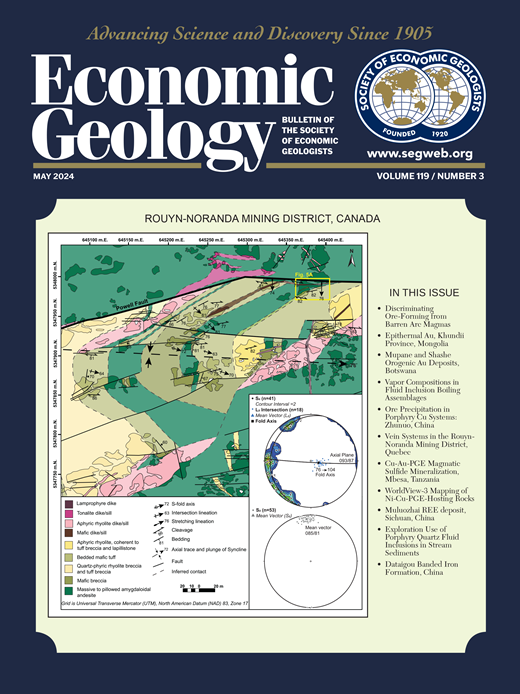通过电气石的原位化学成分和δ18O-δ11B成分追踪三叠纪查卡尔塔亚地区(玻利维亚雷阿尔山脉)的锡矿化情况
IF 4.9
1区 地球科学
Q1 GEOCHEMISTRY & GEOPHYSICS
引用次数: 0
摘要
我们对玻利维亚雷亚尔山脉三叠纪查卡尔塔亚Sn多金属区的电气石进行了岩石学和地球化学研究。电气石与灰岩、角砾岩和矿脉有关,它们出现在三叠纪查卡尔塔亚过铝花岗岩群周围,由志留纪变质岩所承载。已确定的热液电气石主要有三种岩相类型:与前矿石灰岩相关的(Tur-1)、与同矿石角砾岩相关的(Tur-2)和与同矿石矿脉相关的(Tur-3)。這三種電氣石均屬於鹼性電氣石組別,其富鐵成分大多接近鈉礦石末端成員。重疊的鐵/(鐵+鎂)比率顯示電氣石沉積期間的熱液成分大致相同。次要元素和微量元素含量的最顯著差異包括 Tur-1 的 Zn 和 Li 相對富集,以及 Tur-3 的 Ca、Sc、V、Cr、Sr、Sn、Y、Cs、Be 和 Zr 相對富集,而 Tur-2 的成分則介乎 Tur-1 和 Tur-3 之間。从 Tur-1(平均百万分之 14)到 Tur-2(平均百万分之 311)和 Tur-3(平均百万分之 476),锡逐渐富集,这表明热液系统中锡浓度的增加与锡石在角砾岩和矿脉中的沉积相吻合。从 Tur-1 的高 Li 和 Zn 含量到 Tur-3 的高 Ca、Sr、V 和 Cr 含量,可以解释为反映了岩浆源热液与变质岩之间的相互作用。所有電氣石類型都有強烈和相對穩定的正 Eu 異常現象,顯示出主要的熱液還原條件。对与绿泥石有关的 Tur-1 进行的原位 δ18O 和 δ11B 分析表明,其结晶与来自过铝 S 型花岗岩的岩浆水处于同位素平衡状态。相比之下,与角砾岩相关的 Tur-2 和与岩脉相关的 Tur-3 的 δ18O 值较高,表明其结晶与变质源流体或岩浆流体在同位素上处于平衡状态,而岩浆流体与变质岩母岩之间存在不同程度的相互作用。地球化学建模再现了岩浆流体与变质岩主岩之间在 0.1 至 0.5 的中等水/岩比率下的相互作用。我们的结论是,查卡尔塔亚地区的锡石矿化主要是通过富含硼锑的岩浆流体与变质岩之间的相互作用形成的。本文章由计算机程序翻译,如有差异,请以英文原文为准。
Tin Mineralization in the Triassic Chacaltaya District (Cordillera Real, Bolivia) Traced by In Situ Chemical and δ18O-δ11B Compositions of Tourmaline
We present a petrographic and geochemical study of tourmaline from the Triassic Chacaltaya Sn-polymetallic district in the Cordillera Real of Bolivia. Tourmaline is associated with greisens, breccias, and veins, which occur around the Triassic Chacaltaya peraluminous granitic stock hosted by Silurian metasedimentary rocks. Three main petrographic types of hydrothermal tourmaline have been identified: pre-ore greisen-related (Tur-1), syn-ore breccia-related (Tur-2), and syn-ore vein-related (Tur-3). The three types of tourmaline belong to the alkali group and have Fe-rich compositions mostly close to the schorl end member. Overlapping Fe/(Fe + Mg) ratios suggest broadly similar compositions of the hydrothermal fluids during the deposition of tourmaline. The most notable differences in minor and trace element contents include relative enrichment in Zn and Li in Tur-1 and relative enrichment in Ca, Sc, V, Cr, Sr, Sn, Y, Cs, Be, and Zr in Tur-3, with Tur-2 showing intermediate compositions between those of Tur-1 and Tur-3. The progressive enrichment in Sn from Tur-1 (avg = 14 ppm) through Tur-2 (avg = 311 ppm) and Tur-3 (avg = 476 ppm) indicates an increase of Sn concentrations in the hydrothermal system coinciding with cassiterite deposition in breccias and veins. The transition from high Li and Zn contents in Tur-1 to elevated Ca, Sr, V, and Cr contents in Tur-3 is interpreted as reflecting interaction between a hydrothermal fluid of magmatic origin and the metasedimentary country rocks. Strong and relatively steady positive Eu anomalies in all tourmaline types suggest dominantly reduced hydrothermal conditions. In situ δ18O and δ11B analyses of greisen-related Tur-1 reveal crystallization in isotopic equilibrium with magmatic water derived from a peraluminous S-type granite. In contrast, higher δ18O values of breccia-related Tur-2 and vein-related Tur-3 indicate crystallization in isotopic equilibrium with a fluid of metamorphic origin or a magmatic fluid that variably interacted with the metasedimentary host rocks. Geochemical modeling reproduces interactions between a fluid of magmatic origin and the host metasedimentary rocks at moderate water/rock ratios between 0.1 and 0.5. We conclude that cassiterite mineralization in the Chacaltaya district was formed primarily through interaction between B-Sn–rich magmatic fluids and the metasedimentary country rocks.
求助全文
通过发布文献求助,成功后即可免费获取论文全文。
去求助
来源期刊

Economic Geology
地学-地球化学与地球物理
CiteScore
10.00
自引率
6.90%
发文量
120
审稿时长
6 months
期刊介绍:
The journal, now published semi-quarterly, was first published in 1905 by the Economic Geology Publishing Company (PUBCO), a not-for-profit company established for the purpose of publishing a periodical devoted to economic geology. On the founding of SEG in 1920, a cooperative arrangement between PUBCO and SEG made the journal the official organ of the Society, and PUBCO agreed to carry the Society''s name on the front cover under the heading "Bulletin of the Society of Economic Geologists". PUBCO and SEG continued to operate as cooperating but separate entities until 2001, when the Board of Directors of PUBCO and the Council of SEG, by unanimous consent, approved a formal agreement of merger. The former activities of the PUBCO Board of Directors are now carried out by a Publications Board, a new self-governing unit within SEG.
 求助内容:
求助内容: 应助结果提醒方式:
应助结果提醒方式:


